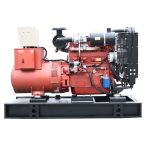Introduction
Diesel generators are essential power sources in various industries, providing a reliable backup power supply when grid power is unavailable or unreliable. In Best brands for 400kW generators , such as coastal areas or marine applications, the challenges faced by diesel generators are heightened due to the corrosive nature of saltwater. In this article, we will explore the unique considerations and requirements for diesel generators operating in saltwater environments, as well as the best practices for ensuring their reliability and longevity.
Understanding the Challenges of Saltwater Environments
Saltwater is highly corrosive and can cause significant damage to equipment and machinery if proper precautions are not taken. When it comes to diesel generators, exposure to saltwater can lead to accelerated corrosion of metal components, including the engine, alternator, and electrical connections. This corrosion can result in decreased performance, increased maintenance requirements, and ultimately, premature failure of the generator.
In addition to corrosion, saltwater environments also present challenges related to humidity, temperature fluctuations, and airborne salt particles. These factors can further contribute to the degradation of the generator components and reduce its overall efficiency and lifespan. Therefore, it is crucial to implement specific measures to protect diesel generators operating in saltwater environments and ensure their reliable performance.
Design Considerations for Diesel Generators in Saltwater Environments
When selecting a diesel generator for use in a saltwater environment, several key design considerations should be taken into account to mitigate the effects of corrosion and other environmental factors. These considerations include:
1. Enclosure and Housing: The generator should be housed in a corrosion-resistant enclosure that provides protection against saltwater ingress. Stainless steel or aluminum enclosures are commonly used in saltwater environments due to their high resistance to corrosion.

2. Coatings and Finishes: All metal components of the generator should be coated or finished with corrosion-resistant materials to provide an additional layer of protection against saltwater exposure. This includes the engine block, alternator, and other critical components.
3. Sealing and Gasketing: Proper sealing and gasketing of the generator components are essential to prevent saltwater intrusion into sensitive areas. Seals and gaskets should be made of durable materials that can withstand exposure to saltwater and maintain their integrity over time.
4. Cooling System: The cooling system of the generator should be designed to operate efficiently in saltwater environments, where higher ambient temperatures and humidity levels are common. Specialized cooling solutions, such as saltwater-resistant radiators or heat exchangers, may be required to ensure optimal performance.
5. Electrical Connections: All electrical connections and wiring should be properly insulated and protected from saltwater exposure to prevent short circuits and electrical failures. Corrosion-resistant materials should be used for all electrical components to maintain reliable operation.
Maintenance and Care Practices for Diesel Generators in Saltwater Environments
In addition to selecting a suitable diesel generator design for saltwater environments, regular maintenance and care practices are essential to ensure the longevity and reliability of the equipment. Some key maintenance practices include:
1. Regular Inspections: Conduct regular visual inspections of the generator to check for signs of corrosion, leaks, or other damage caused by saltwater exposure. Address any issues promptly to prevent further deterioration of the equipment.
2. Cleaning and Washing: Periodically clean the generator and its components to remove salt deposits and other contaminants that can contribute to corrosion. Use fresh water and mild detergents to clean the generator thoroughly while avoiding high-pressure washing, which can force saltwater into sensitive areas.
3. Lubrication and Rust Prevention: Apply lubricants and rust inhibitors to metal components to protect them from corrosion and ensure smooth operation. Use specialized coatings or sprays designed for saltwater environments to provide long-lasting protection against rust and degradation.
4. Filter Replacement: Replace air, fuel, and oil filters regularly to maintain the efficiency and performance of the generator. Saltwater environments can accelerate filter clogging and deterioration, leading to decreased engine performance and increased fuel consumption.
5. Monitoring and Testing: Implement a comprehensive monitoring and testing program to track the performance of the generator and detect any issues before they escalate. Monitor fuel consumption, temperature levels, oil pressure, and other critical parameters to ensure the generator is operating within optimal parameters.
Conclusion
Diesel generators play a critical role in providing backup power in saltwater environments, where the challenges of corrosion and environmental exposure are amplified. By selecting a diesel generator designed specifically for saltwater applications and implementing proper maintenance and care practices, operators can ensure the reliable performance and longevity of their equipment. With careful consideration of design factors, regular maintenance routines, and proactive monitoring, diesel generators can continue to provide a dependable power supply in even the harshest saltwater environments.
